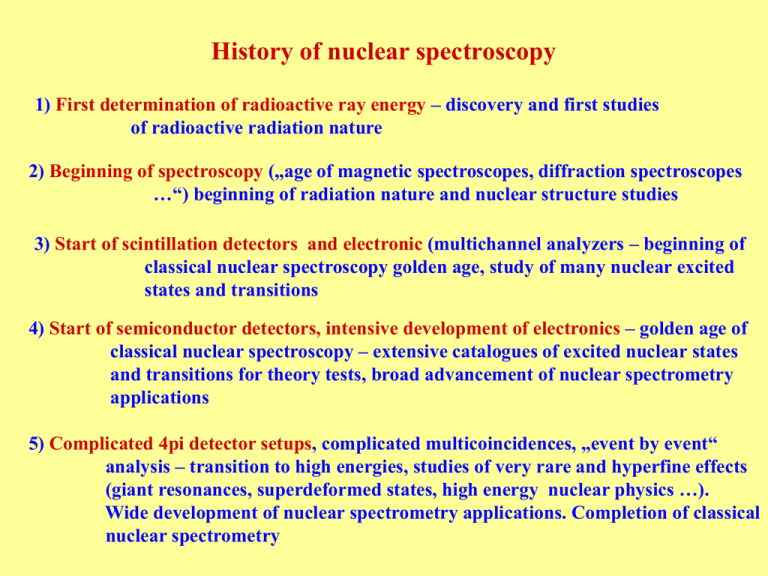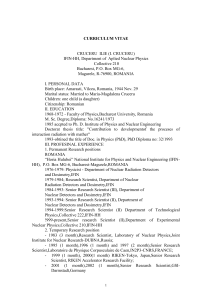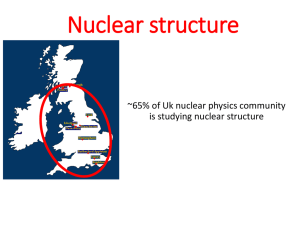History
advertisement

History of nuclear spectroscopy 1) First determination of radioactive ray energy – discovery and first studies of radioactive radiation nature 2) Beginning of spectroscopy („age of magnetic spectroscopes, diffraction spectroscopes …“) beginning of radiation nature and nuclear structure studies 3) Start of scintillation detectors and electronic (multichannel analyzers – beginning of classical nuclear spectroscopy golden age, study of many nuclear excited states and transitions 4) Start of semiconductor detectors, intensive development of electronics – golden age of classical nuclear spectroscopy – extensive catalogues of excited nuclear states and transitions for theory tests, broad advancement of nuclear spectrometry applications 5) Complicated 4pi detector setups, complicated multicoincidences, „event by event“ analysis – transition to high energies, studies of very rare and hyperfine effects (giant resonances, superdeformed states, high energy nuclear physics …). Wide development of nuclear spectrometry applications. Completion of classical nuclear spectrometry Discovery of X-rays and radioactivity 1895 – discovery of X-rays (W. C. Roentgen) 1896 – discovery of radioactivity H. Becquerel (by means of photographic plate) (fluorescence, scintillation, photographic plate and latter gas filled ionization chamber are used for detection) W.C. Roetgen 1900 – identification of alpha, beta and gamma rays (E. Rutherford, P. Villard …) 1908 – gas filled detectors (E. Rutheford, Geiger) Proportional counters – energy determination using full stopping of charged particle (from particle range) Gamma rays – photoeffect and stopping of photoelectron First X-ray photograph Alpha particles were observed using microscope by means of ZnS scintillation in the original Rutheford experiment First energy determination (Studies of basic properties of radioactive rays ) 1905 – W. Bragg, R. Klieman – measurement of alpha range at gas – different ranges → different energies – discrete spectra 1906 -11 - O. Hahn, L. Meytner – beta absorption at material → is not exponential → not only one energy, (incorrect assumption of exponential decreasing of monoenergetic electron beam intensity) O. Hahn, O. von Bayer - magnetic field usage + photographic plate → first magnetic spectrograph of electrons → complicated spectrum 1914 - James Chadwick beta spectrum is also continuous - definitely confirmed by calorimetrical measurements of C.D. Ellis and W. Wooster in the year 1927 1911 - Wilson cloud chamber ( C.T.R. Wilson) – energy from trace length Inventor of cloud chamber C.T.R. Wilson and his first photographs of alpha and beta particles Begining of real spectroscopy 1912-15 - energy determination - Bragg diffraction on crystal planes Max von Laue, W.H. a W.L. Braggs Father and son Braggs Max von Laue Laue diagram No 5 from 1911 - 13 – beginning of spectroscopy studies Electron and alpha movement through magnetic field (alphas needs strong field) 1913 - First focusing beta spectrographs 1914 – Gamma energy measured by crystal diffraction method 1914 – Accuracy of alpha energy measurement ~ 1% One of first crystal diffraction spectrometers (detection by ionization chamber) – F.C. Blake, W. Duane, Phys Rev 10(1917)624 Beginig of neutron spectroscopy, scintillator detectors 1930 – 1932 discovery of neutrons by W. Bothe and H. Becker (bombardment of Be, B or Li by alpha particles). J. Chadwick - neutral particle with mass near to proton - neutron. Detection by means of reactions, energy determination by the help of refracted proton Thirties and forties – artificial radioisotopes are accessible (P. and M. Curie, E. Rutheford), first accelerators 1944 – Curran, Baker invent photomultiplier 1948 – NaI(Tl) scintillation detector R. Höfstadter – high efficiency, energy determination in wide range spectra, FWHM ~ 7% much later further materials (BGO, BaF2, plastics …) R. Höfstadter and his article about NaI(Tl) crystals at Physical Review from the year 1949 Figure of NaI(Tl) signal compared with signal from pulser. Broad development of classical spectroscopy (scintillation detectors and magnetic spectrometers) Example of work in the field of conversion electron spectroscopy From forties, magnetic spectrograph, photographic method Parallel development - better magnetic spectrometers of electrons (better energy resolution than NaI(Tl)) gamma transitions – by means of parallel conversion - photoeffect and determination of photoelectron energy disadvantage - electronic singlechannel, small solid angles,a higher energies → low conversion coefficients - electrostatic spectrometers Continuation of crystal diffraction spectrometers: (resolution – for 100 keV is FWHM ~ 1 eV very low efficiency) very accurate measurements of very intensive lines – calibration standards Studies of nuclear structure, excited states, transitions … Semiconductor detectors, development of electronics Development of multiparametric multichannel analyzers – efficient usage of scintillation detectors, coincidences, time characteristics, development of electronics 1960 – Semiconductor Ge(Li) detectors, resolution FWHM = 5 keV → 2 keV (very small energy needed for production of electron hole pair ~ 3 eV) later also Si(Li) Complex on beam measurements Splitting to: application (medicine, material research…) basic research (studies of nuclear structure and reaction mechanism) ~ 1970 – HPGe – continual temperature of liquid nitrogen is not needed, better resolution and efficiency, smaller noise 1983 – USA abandoned of commercial production of Ge(Li) detectors 1971 – anticompton spectrometer J.Konijn – suppression of compton background up to one order Golden age of classical spectrometry, its completion and development of applications Present commercial HPGe detector of PGT company Complex electronic experiments → high energies, rare phenomena The eighties and nineties – complex set-ups of scintillation detectors: study of nuclear structure – crystal sphere medical applications – PET chambers later combination of HPGe (anticompton) and scintillator for gamma rays and „miniorange“ spectrometers for electrons plastic scintillator „sandwich“ – identification of diferent charged particles (Nordball, Crystalball, Plasticball … Set-up of HPGe detectors JUROSPHERE Combination of many types of detectors for different particles Complex electronic systems, superconductive magnets „Event by event“, 4π detectors, high energy and heavy ion experiments (Plastic Ball) New types of materials PbWO4, … Plastic Ball at KVI Groningen Enable: Study of phenomena with very small probability, high multiplicities, complex coincidences, high energies … nuclear structure - superdeformed states, giant resonances, very accurate spectrometry – search of neutrino mass





![The Politics of Protest [week 3]](http://s2.studylib.net/store/data/005229111_1-9491ac8e8d24cc184a2c9020ba192c97-300x300.png)


